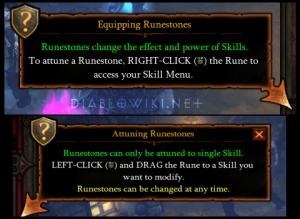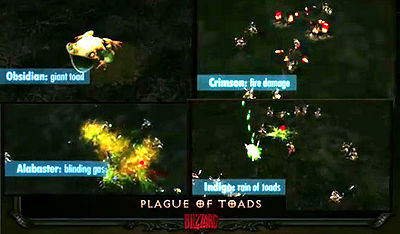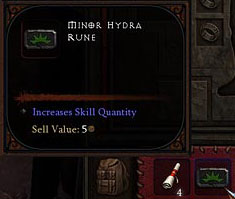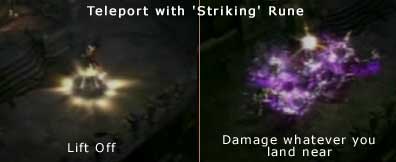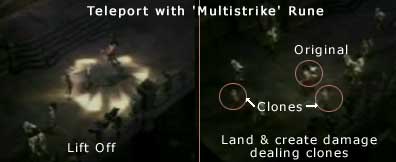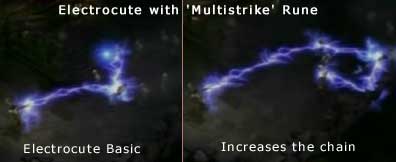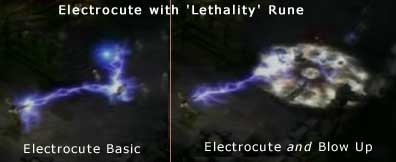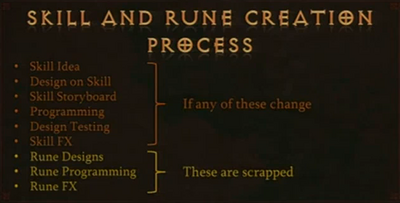Rune Archive

|
Archived Article [e] Rune Archive is an archived article about material previously included in Diablo 3. However, it has currently been removed or the article contains outdated facts. The information is stored in Diablo Wiki for posterity. Please note: Links in this article lead to both updated and archived material. This article was last up to date:
|
See the main runestones page for up to date information about runes. This page archives older runestone info, and traces the evolution of this game system since it was first revealed in 2008.
Contents
- 1 Earlier Rune Development
- 1.1 Runestone Functions
- 1.2 Basics (Old Version)
- 1.3 Rune Tool Tips
- 1.4 Proposed Changes to Rune Functionality
- 1.5 Early Functions
- 1.6 Higher-Level Runestone Functions
- 1.7 Runestone Scarcity
- 1.8 Rune Crafting/Upgrading
- 1.9 Easy Socketing
- 1.10 Confirmed Runestone Examples
- 1.11 Plague of Toads
- 1.12 Poison Dart
- 1.13 Hydra
- 1.14 Throw Weapon
- 2 Original Rune Functions
- 3 Evolution Of The Runestone Naming-Scheme
- 4 Rune Tool Tips
- 5 Rune Appearance Evolution
- 6 Rune Function Examples
- 7 Hydra: The First Five Rune Example
- 8 BlizzCon 2009
- 9 Rune Storage
- 10 Diablo II Runes
- 11 Trivia (Rune History)
- 12 References
The below was added to this archive on 1 March 2012.
Earlier Rune Development[edit | edit source]
Entries about previous iterations of the rune system can be seen below. While this information is out of date, it is kept here for archival purposes.
Runestone Functions[edit | edit source]
Runes have no function on their own, other than beautifying your inventory. They are only useful once they're socketed into a skill, where they alter the skill's function. All runes improve the base skill effect, and in every known case any rune is better than no rune at all.
That said, a rune'd skill may not be an improvement over the base skill in every situation -- using a rune to change a fire attack to a cold attack (as the Crimson rune does to the Hydra skill) would obviously be a poor choice against cold resistant monsters.
The functions of each type of rune in each skill vary widely. While the early runestone system had fairly predictable bonuses -- certain runes added +damage, or multishot, or lowered the resource cost in almost every skill -- the complexity and variety of rune effects grew steadily over the course of game development.
Devising and implementing the effects of the Runestones was a tremendous amount of work for Diablo III's developers and artists; there are nearly 120 skills in the game, each with a basic function which is modified in at least four or five totally different ways by each runestone.
Basics (Old Version)[edit | edit source]
Runestones come in five types, and a particular kind of bonus or alteration is typical of each. For instance, the Crimson Rune generally adds damage or a fire effect. However the effects that runestones have vary greatly with the skills themselves - a skill that doesn't deal damage may not gain a damaging effect from a Crimson Rune, but rather be altered in some other way.
In addition to the five types, Runestones also occur in seven levels of quality, with increasingly potent effects. A Runestone of one level always has a more dramatic effect than a Runestone of a lower level, usually in the sense that it affects a given skill in the same way, but to a greater extent. It is not generally known whether or not it will be possible to combine Runestones of one quality level to generate higher-level Runestones, however all seven quality levels are dropped by monsters[1].
The Runestone naming scheme has changed several times during development. The current iteration was devised in early 2010 and made public in May of that year when Bashiok [2] revealed the names to be Crimson, Indigo, Obsidian, Golden and Alabaster. This change coincided with considerable changes to their effects. The current effects to all skills can be viewed with the Blizzard build calculator, released along with the Beta.
Rune Tool Tips[edit | edit source]
The tool tip that displays when a rune is hovered over is not informative. It simply says, "socket in skills for a special bonus." To obtain information about what a rune actually does, players need to click on the rune to pick it up, then hover it over their available skills. The tool tip will then briefly describe what effect the rune will grant that skill.
Since just the word descriptions aren't that informative, most players will want seek out additional information from a wiki or video of the skill in action. Or simply plan on testing out a lot of rune functions before deciding on what they want to use long term.
Proposed Changes to Rune Functionality[edit | edit source]
The following portion is still theory for the development team, revealed on August 1st, 2011, after a press event. Jay Wilson described a slightly changed rune system from what fans are accustomed to.
Note that this system is still theoretical, it has not been implemented or tested and it is unknown whether it will be released in any form.
The proposed change does not fundamentally alter the function of runes. The core function of socketing a rune into a skill to change how the skill works is still present. However, the "color" system of the runes would be dropped in favor of runes that are "Unattuned". The player would "attune" the rune by socketing it into a skill. Whatever effect the rune would have on the skill would not be known beforehand, making runes sort of similar to Jewels in Diablo II. In addition to this, each rune, once attuned (or identified to follow Diablo parlance) would also have another passive benefit on it, such as an increase to Attack or another stat. This is perhaps an attempt by the development team to add in more customisation after the loss of Charms and the Talisman. Once the rune is socketed and attuned, it would then be permanently fixed, unless they chose to add in a crafting recipe to "wipe" the rune back to a blank slate.
Early Functions[edit | edit source]
Prior to Blizzcon 2010, the Runestones (which had different names at the time) were generally accepted to do the following:
- Alabaster rune: Wild card functions.
- Crimson rune: Generally provides +damage and/or fire damage.
- Golden rune: Generally reduces the resource cost.
- Indigo rune: Generally provides multishot in some form.
- Obsidian rune: Wild card functions.
At Blizzcon it was revealed that this simple, predictable approach, had largely been discarded.
Higher-Level Runestone Functions[edit | edit source]
A Runestone's function tends to vary in a quantitative way with its level of quality, rather than in a qualitative way. For example, an Indigo Rune adds multishot to Magic Missile; higher level Indigo Runes don't change that function, but rather increase the number of projectiles generated. However Runestones of some quality levels also have qualitative advantages over lower-level Runestones of the same type.
Bashiok: Yes, the mechanic stays the same for the rune type in all ranks (more or less). It simply increases in power. For the Alabaster-in-Poison Dart example I’m actually not sure the increase in effect, but it likely plays off of the stun effect (higher ranks stun the target for longer). Runes that reduce cost reduce even more cost as the rank increases. A rune that would cause multiple projectiles would fire even more projectiles as the rank increases, etc.
It’s not necessarily a hard and fast rule though that the increase must only be one thing. Maybe it means more projectiles AND ups the damage a little to make sure it remains competitive with other runes or skills. It has to be a somewhat fluid system.
Runestone Scarcity[edit | edit source]
There are seven Runestone quality levels, roughly distributed so that levels one and two are found as a character progresses through Normal, three and four are found in Nightmare, five and six in Hell, and the final seventh rank is found exclusively in Inferno (each Runestone's quality can be determined by the number of points around its edge). It's not known how common or rare Runestones will be, or whether or not all five types will be equally difficult to find. The most recent information about the subject came from a forum post by Bashiok in January 2011.[3]
Bashiok: That’s a good question, I can see how that could be justified. I don’t know what the plan is there, I’ll have to ask. My gut is that it would be too much to keep some type of rune ‘power rating’ in mind when altering drop rates, especially post-release where patches could jumble them around a fair bit. “This rune sucks now but it’s still the rarest!”
Also, ideally, each rune type will be equally viable to different people and builds. Saying one is more powerful than another would mean we’re probably balancing them to be, and that’s not the case.
Rune Crafting/Upgrading[edit | edit source]
The D3 Team has confirmed that the Mystic will have some crafting recipes to create new Runestones, though there are no details yet, other than that they will use old Runestones in the process. It will also be possible to salvage unneeded Runestones for magical materials, and even make new ones from scratch.
It's not known if the Mystic can upgrade the quality of runestones though, as the jeweler can by combining three gems of the same type/level to create one of the next higher level.
Easy Socketing[edit | edit source]

Socketed runestones will be freely swappable. Players will be able to replace runestones at any time, at no cost and without risk of losing the runestone. The D3 Team has committed to easy runestone swapping in the final game, but they have said there will be some sort of limitation, purely to prevent macro-switching exploits. They want swapping to be easy and forgiving, but not something that can be done automatically by a third party program, which could lead to constant, effortless switching, which they think of as contrary to their intended style of play.
The team has not yet revealed what form this limitation will take, but it could be something as simple as requiring players to return to town, or to use one of the Artisans to switch out runes.
Confirmed Runestone Examples[edit | edit source]
While one or two rune properties are known (or can be easily guessed) for most skills, Blizzard has only revealed all five runestone effects for a few skills. There may yet be additional changes to these effects, as development continues up to and even after release. With the release of the Beta, Blizzard revealed the build calculator, which has detailed information on all of the current rune enhancements. See below for some examples (historical and current).
Plague of Toads[edit | edit source]
The rune functions for Plague of Toads, a Witch Doctor skill were revealed during a panel discussion at Blizzcon 2010. The basic skill has the Witch Doctor throwing out several toads, which hop forwards in erratic, Charged Bolt-esque fashion.
- Alabaster rune: The toads also blind enemies.
- Crimson rune: Flaming toads add fire damage to their attack.
- Golden rune: Reduced cost per cast.
- Indigo rune: Changes the skill to a rain of toads, which fall down on the targeted location.
- Obsidian rune: Summons a single, huge, stationary frog that uses a sticky tongue to capture and consume monsters in one gulp. It spits out the treasure and items. The mega-toad can eat Champions (possibly only at higher/highest rune level?), but not bosses or (presumably) bigger enemies.
Poison Dart[edit | edit source]
The rune functions for Poison Dart, a Witch Doctor skill, were revealed during a panel discussion at BlizzCon 2010. The basic skill is a fairly slow-working spell that fires a single poison dart that deals poison damage and some DoT.
- Alabaster rune: Blows out a face-biting snake that stuns the target
- Crimson rune: Adds fire damage to the poison dart.
- Golden rune: Steals mana with each dart hit.
- Indigo rune: Fires multiple darts.
- Level One: Two darts.
- Level Two: Four darts.
- Obsidian rune: Slows the poisoned target.
Hydra[edit | edit source]
The rune functions for Hydra, a Wizard skill were revealed during a panel discussion at Blizzcon 2010. The basic skill summons a fiery dragon that breaks through the earth and spits firebolts at nearby enemies.
- Alabaster rune: Turns the Hydra purple and the damage type to Arcane.
- Crimson rune: Turns the Hydra blue and the damage type to a short-range chilling frost spray.
- Golden rune: Creates a giant hydra that deals higher damage via AoE Firewalls.
- Indigo rune: Turns the hydra blue and the projectiles to lightning balls that never miss.
- Obsidian rune: Turns the hydra green and the damage to a splashing poison acid.
This Hydra information was revealed at Blizzcon in October 2010. It shows changes even since August, when one of Hydra's rune effects was a faster/multishot, instead of the Acid element.
These bonuses also show how unpredictable the effects are. By previous knowledge and logic, Crimson should be the +damage/firewalls effect, since it generally adds damage and/or fire effects. Possibly the developers are shuffling rune bonuses around randomly, in order to make the runes equivalently useful. Rather than, for instance, allowing Crimson to be the most useful and Golden the least, on the whole.
Throw Weapon[edit | edit source]
The rune functions for Throw Weapon, a Barbarian skill, were revealed during a panel discussion at Blizzcon 2010. The basic skill is a ranged attack in which the Barbarian is able to hurl his weapon with distance and accuracy. The weapon magically reappears in his hands after each toss.
- Alabaster rune: Enemies struck by the weapon grow confused.
- Crimson rune: Adds damage to the thrown weapon.
- Golden rune: Throws a monster corpse rather than the weapon. Less range, but bigger damage.
- Indigo rune: Adds ricochet, allowing the weapon to strike multiple targets.
- Obsidian rune: Throws a stunning hammer, rather than the equipped weapon.
The below was added to this archive on 26 July 2011.
Original Rune Functions[edit | edit source]
Jay Wilson described the five types of runes during an interview from BlizzCon 2009. The quoted sections below are Jay's words: [4]
- "One tends to be more damage-oriented. One tends to multiply effects, splits projectiles or bigger radiuses, things like that. One tends to be a very energy-efficient rune, so you cut down cost or in some way increases the benefit of the skill, so you get more for less. One tends to be more focused on death effects, critical effects. And one of them we call just... the weird rune, which is our grab bag for anything unusual we want to stick on."
Evolution Of The Runestone Naming-Scheme[edit | edit source]
The names of the Runestones have changed at least twice during development. The original names were very straight-forward, describing what the runes did. They were then changed to a more evocative set of names, which proved too limiting when their functions were overhauled in early 2010, when the names were changed again, to their current color-based names.
The list below traces their name changes over time, from the earliest to the current.
- Unknown > Energy Rune > Golden rune
- Lethality Rune > Viper Rune > Obsidian Rune
- Multistrike Rune > Hydra Rune > Indigo Rune
- Power Rune > Force Rune > Crimson Rune
- Unknown > Striking Rune > Alabaster Rune
Bashiok shed some light on the reason for the latest change in 2010:[5]
- Bashiok: The runes have really just been renamed to allow us greater flexibility in what they do so we’re not creating a weird detachment from what they’re called and the effect they provide. For example what was the multi-strike rune going to do for ... say, Slow Time? And does that match what the name implies, or what you would assume? Probably not.
A few days later, he elaborated:[6]
- Bashiok: ...the purpose of renaming them was... to remove a strict theme. I’m not aware of any rune effects we’ve shown being removed - I think all those still exist just the way they were shown. Just instead of multi-strike/hydra, it’s called Indigo, and while for a lot of skills it still has a very 'multi-strike' theme, it’s not a rule dictated by the name.
Rune Tool Tips[edit | edit source]
As of the Blizzcon 2010 demo, no rune gave any useful information when hovered over. They simply said, "socket in skills for a special bonus." However, when you click to pick up a rune and hover that over a skill with an open socket, an informative tool tip pops up, explaining in clear terms what the rune will do for the skill.
This isn't always enough to know clearly just how useful the rune will be; experience or screenshots/information on websites (such as this wiki) will be necessary to really understand the strengths and weaknesses of each rune in each skill.[7]
These tool tips were in for the Blizzcon 2010 PvM demo, but most players found that runes still had to be experimented with. For instance, one rune in Magic Missile said the projectile became a homing missile. This sounded good, but when tested the rune just let the Missile change direction, once, and not in a direction the player could control or predict. The effect sort of allowed the Wizard to shoot around a corner, but not very accurately or consistently, and it was not useful to shoot past front row monsters to hit the mages in the rear, since there was no way to make the Missile target the desired enemy.
Not all rune effects are unimpressive, and most are huge ugrades over the base skill, but just reading the description on the tool tip is in no way sufficient for players to make an informed choice. Players will want to read the rune descriptions in this wiki, view movies of the rune effects, and try the runes out themselves, time permitting. Ultimately, the rune tool tips will likely be of most use as a memory aid, reminding players of the rune functions they've seen previously.
Rune Appearance Evolution[edit | edit source]
As of BlizzCast episode 8 (30th of March, 2009) [8] Runes and Rune Sockets were horizontal rectangles, as seen in the image to the right. Previously, runes and their sockets had been square-shaped.
A more recent image, from August 2010, is seen to the left. Runes are now round, like marbles, and bear striking glyph graphics. In light of this change, it's assumed that the sockets in skills are now round as well.
Rune Function Examples[edit | edit source]
The D3 Team gave several examples of rune functions during a panel at BlizzCon 2008 when Skill Runes were first revealed as a game feature. (Watch the demonstration on YouTube.) The rune names have all changed since this time. The rune/skill functions have not all changed, but they have been modified somewhat. See the sections further up this page, or on the individual skill pages, for current/accurate information.
Wizard's Mirror Image[edit | edit source]
Mirror Image Skill: This skill, from the Conjuring Skill Tree, creates a duplicate of the wizard, which is capable of moving around and using spells to attack monsters. (It's not just a decoy or an illusion.)
Hydra/Multistrike Rune: Socketing this rune would increase the number of duplicates. Higher quality levels of the hydra/multi-strike rune would presumably add more duplicates.
Force/Power Rune: Socketing this rune would increase the hit points of each duplicate, and increase the spell's duration.
Wizard's Teleport Skill[edit | edit source]
Teleport skill: This skill, from the Arcane Skill Tree, teleports the Wizard to the targeted location. The spell isn't quite as quick as it was in Diablo or Diablo 2, since the Wizard leaps up into the air before vanishing, and appears in the air, then falls down to earth.
Striking Rune: Adds damage to targets near where the Wizard appears, functioning something like the Barbarian's Leap Attack skill.
Hydra/Multistrike Rune: Creates a temporary duplicate of the Wizard that will attract enemy fire and will fight and deal damage as well. (This seems to be basically a free way to cast Mirror Image when you Teleport.)
Witch Doctor's Skull of Flame[edit | edit source]
Skull of Flame skill: The Witch Doctor lobs a flaming skull, grenade style, which explodes on impact, dealing substantial fire damage to nearby targets. Different runes affect this skill in different ways. Here are a couple of examples as presented during a BlizzCon 2008 panel discussion.
Hydra/Multistrike Rune: Socketing this rune causes the flaming skull to skip along the ground, like a stone over water, bounding and creating multiple explosions. Higher quality runes would allow additional bounces.
With Force/Power Rune: Socketing this rune adds a firefield property to the Skull of Flame, creating a small patch of flame on the ground that persists after the skull's explosion and damages any monsters that cross over it.
Wizard's Electrocute[edit | edit source]
Electrocute skill: This skill, from the Storm Skill Tree creates a strand of lightning that locks onto an enemy like a beam weapon, dealing steady lightning damage.
Hydra/Multistrike Rune: Socketing this rune allows the lightning to chain to multiple targets.
With Viper/Lethality Rune: Socketing this rune causes some of the monsters killed by Electrocute to explode in a nova, dealing damage to other nearby enemies.
Hydra: The First Five Rune Example[edit | edit source]
The first good example of how runes were going to work in the final game came from Jay Wilson at Gamescom 2010.[9]
- Jay Wilson: One of my favorites is on the Wizard. She has a skill called Hydra, which is largely the same as it was in Diablo 2. Fiery (dragon) heads that shoot fireballs. Depending on which rune the Wizard sockets in that skill, the dragon heads change elements, and it’s a major change. Their entire appearance is altered. They can become poison heads, which shoot bolts of poison that leave pools of acid on the ground. There are lightning heads that shoot Chain Lightning. Cold heads that shoot Frost Bolts that slow enemies. Another rune makes for a bigger fire attack, where the head just breaths a cone of flame.
Jay did not list what all five runes did in Hydra, and his explanation left fans confused. Where were the three elemental damage types coming from? Nothing like that seemed to fit wit the previous rune functions.
This confusion was largely cleared up a few days later when Bashiok spoke privately to Diii.net about this issue, and explained most of the questions left by Jay's new info. [10]
From his words, we were made to understand that in Hydra, the five runes provide: 1) extra damage (with a changed fire form), 2) Multistrike (rapid fire), 3-5) the 3 elemental properties. Extra damage and multishot are consistent with previously known rune functions. One of the elementals comes from the wildcard rune, and the other comes from what used to be the Energy rune. That rune now functions as a second wildcard in many skills, since changes to the resources made the mana-saving property obsolete. (Plus it just wasn't cool enough, in most instances.)
So the only unexpected rune bonuses in Hydra are the 4th and 5th elemental modifiers. The +damage, +multishot, and one elemental damage type would have been expected. The other two would more predictably have granted an Arcane Power cost reduction and some sort of critical hit or death effect bonus. That they were changed to grant elemental bonuses just goes to show how much variability and variety the Diablo III team is putting into the runes.
BlizzCon 2009[edit | edit source]
Skill Runes were not enabled at BlizzCon 2009, for reasons Jay Wilson elaborated on during an interview after the show:
- Diii.net: They’re still being reworked and you don’t have any further comment?
- Jay Wilson: They’re not being reworked, we had tons of skill runes on the Wizard and the Barbarian but they were so spotty across the entire class we thought it would be more confusing to show them off than to not. So we just disabled them all for the BlizzCon build. But they’re all still there and they work just fine.
During another interview, Jay Wilson explained the creative process of making a rune, and how making any changes at all to the first steps will scrap the end results entirely, as can be seen in the image on the right. [11]
- Jay Wilson: Well, the system is similar for every class. What we did is we broke down five basic runes. Each rune has a general type of effective pluses. One tends to be more damage-oriented. One tends to multiply effects, splits projectiles or bigger radiuses, things like that. One tends to be a very energy-efficient rune, so you cut down cost or in some way increases the benefit of the skill, so you get more for less. One tends to be more focused on death effects, critical effects. And one of them we call just... the weird rune, which is our grab bag for anything unusual we want to stick on.
- Every active skill -- we define an active skill as a skill that you have to click to activate -- can have all five runes affect it. Each rune will change the function of the skill. Some of the changes are minor, there are some cases where there's not much appreciable effect. And then some cases are much more drastic, where for example with Ice Storm or Blizzard, one of the things we're playing around with, this halo of frost whips around her and anyone that moves through it takes damage. That adds on to the effects that Ice Storm already does. So there's a whole bunch of different... the basic idea is to capture that dream of, I'm gonna customize my skills. Even though you and I have the exact same skills, we don't play the same because our skills are different. And then throughout the game, the runes will upgrade in power. So that will just increase and amplify the effect that they have.
Rune Storage[edit | edit source]
Runes were initially stored in an inventory grid on the skill tree menu; not in the normal inventory. This was changed in development and runes now appear in the main inventory, along with all other items.
Diablo II Runes[edit | edit source]
- Runes - The main page for D2 runes.
- Rune FAQ - All your questions about runes are answered here.
- Rune list - All the runes in Diablo II, and how you can create a Zod rune from a fourteen trillion Els.
- Runewords - See how runewords work.
- Sockets - Get to know more about the socket mechanic.
Diablo I Runes[edit | edit source]
The Diablo I expansion, Hellfire added "runes" as a trap-like type of item. Read more about them in the Diablo I Runes article.
Trivia (Rune History)[edit | edit source]
What do you really know about runes? The ones from our world come from the ancient Vikings, and their "futhark" (equivalence of our 'Alpha Bet(a)') (which again come from the even more ancient Tibetan Yantras). They allegedly hold magic powers, and the magicks of the 'runa' are still practised today. These practices, called "Seden", are of course done mostly as a pastime, but some forms of the old runes were used in proper form as late as early 20th century in the 'Dalarna' area of Sweden...
In Sanctuary, however, runes are magically inscribed symbols. Though their use has changed slightly in the last 20 years, they used to grant (sufficiently prepared) items magical properties. For sages of these runes, magical RuneWords would be created to remake a mundane item into a Runic Item, with powers competing with magical artifacts.
Besides the fact that these supposedly ancient runes hold great and mystic powers, we know little about them. Who created them or how they are created is unknown. They seem to attract demons of different kinds, as they are often found on their corpses. If the runes are of demonic origin is not known either. They could have been the simple writing language of the first inhabitants of Sanctuary, who themselves were more powerful than Demons or Angels. Whatever the origin, they are of great use to heroes wishing to dethrone Diablo or Baal.
References[edit | edit source]
- ↑ Bashiok forum post - Blue Tracker, January 2011
- ↑ Bashiok forum post - Blue Tracker, May 2010
- ↑ Bashiok forum post - Blue Tracker, January 12, 2011
- ↑ Jay Wilson @ Blizzcon 2009 - IGN, August 23, 2009
- ↑ Bashiok forum post - IncGamers May, 2010
- ↑ Bashiok forum post - IncGamers May, 2010
- ↑ Bashiok forum post - IncGamers May 27, 2010
- ↑ BlizzCast - IncGamers, March 2009
- ↑ Jay Wilson @ Gamescon 2010 - G4TV. August 25, 2010
- ↑ Bashiok @ Diii.net - IncGamers. August 28, 2010
- ↑ Jay Wilson Interview - IGN, June 2009
| Items of Diablo III [e] Item Basics Normal Items Crafting Legendary Armor I Legendary Armor II Legendary Weapons 1h Legendary Weapons 2h Item Sets |
|---|

